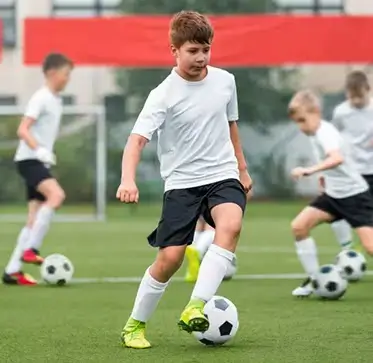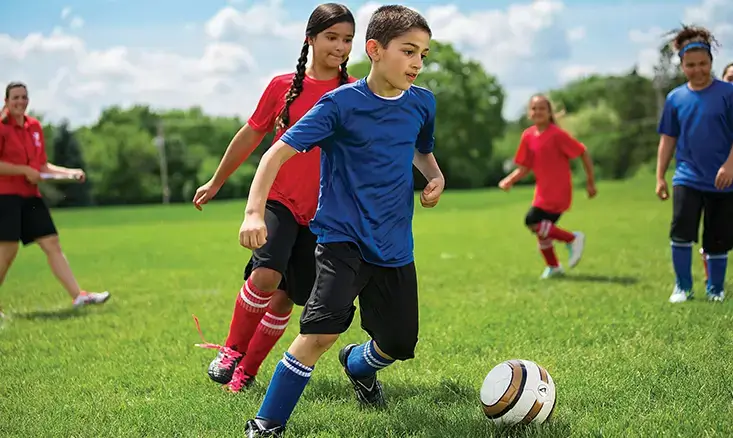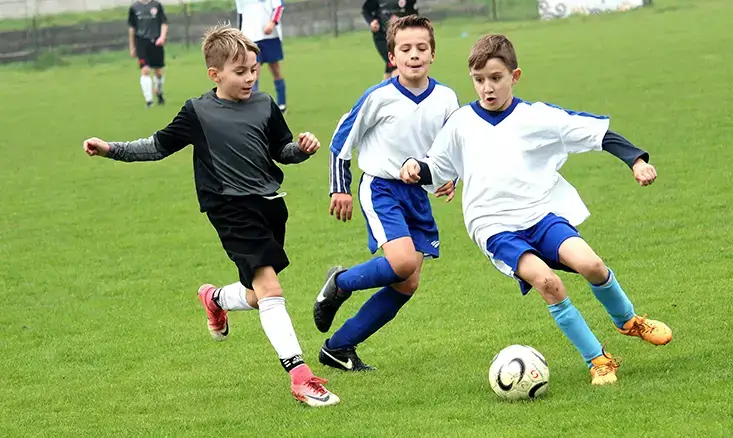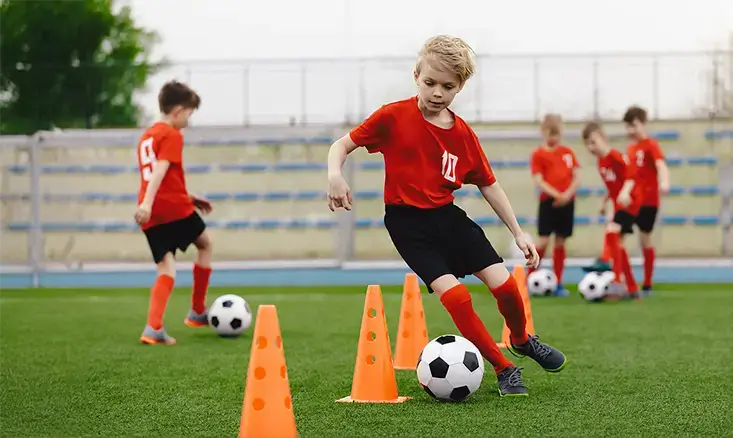Youth Soccer Figure 8 Drills: The Ultimate Guide for Skill Development

CRFC BLOGS
LATEST BLOGS & NEWSLETTERS
Youth Soccer Figure 8 Drills: The Ultimate Guide for Skill Development
Youth soccer is all about learning and improving essential skills like dribbling, passing, and movement on the field. One of the best drills for helping young players develop these skills is the Figure 8 drill. This drill is simple, easy to set up, and very effective at improving a player’s ball control, agility, and coordination.
What Are Youth Soccer Figure 8 Drills?
Youth soccer figure 8 drills help players improve their dribbling and ball control skills. The drill gets its name because it involves moving the soccer ball in a pattern resembling 8. Players dribble around two cones placed a short distance apart in this pattern, forcing them to change direction while controlling the ball quickly.
This drill is great for all ages, especially younger players who are just starting to learn how to handle the ball. It’s easy to set up with just a couple of cones and can be done in a small space, making it perfect for practice at home or on the soccer field.
Why Use Figure 8 Dribbling Drills in Youth Soccer?
Enhances Ball Control and Dribbling Skills
One of the biggest benefits of Figure 8 dribbling drills is how much they improve ball control. Players learn to keep the ball close to their feet by practicing this drill while making quick turns. This is very important in soccer because controlling the ball in small spaces can help you get past defenders and keep possession of the ball.
Figure 8 drills also teach players to use both the inside and outside of their feet, making them more versatile. Young players often rely on one foot or one part of their foot too much, but this drill encourages them to use both feet equally, which makes them more well-rounded players.
Agility and Coordination Development
In soccer, agility is key. Players need to be able to quickly change direction and move their bodies in different ways while controlling the ball. The figure 8 drill helps develop this skill by making players change direction over and over again as they dribble around the cones. This builds coordination between their feet and the ball, which is crucial for good soccer performance.
Builds Confidence in Small-Sided Games
When young players practice figure 8 dribbling drills, they gain confidence in their ability to handle the ball in tight spaces. This is especially helpful in small-sided games or 1v1 situations, where ball control is more important than ever. The more confident a player feels dribbling through cones in practice, the more likely they are to try these moves in a real game.

How to Perform Youth Soccer Figure 8 Drills
Setting Up the Drill
Setting up a youth soccer figure 8 drill is simple. All you need is two cones and a soccer ball. Place the two cones about 1 to 2 yards apart. Younger players can start with the cones farther apart to make the drill easier, and as they get better, you can bring the cones closer together to increase the difficulty.
Step-by-Step Instructions
Here’s how to do the drill step by step:
Starting Position
The player stands in between the two cones with the ball at their feet.
Dribbling
The player begins dribbling the ball in a figure 8 pattern, moving around both cones. They should use small touches and keep the ball close to their feet.
Footwork
Players should focus on using both the inside and outside of their feet to control the ball. For example, when dribbling around the left cone, use the outside of the right foot and the inside of the left foot, and vice versa for the other cone.
Increase Speed
As players get comfortable with the drill, they can increase their speed. The faster they go, the more challenging the drill becomes.

Common Mistakes to Avoid
Some mistakes players commonly make in this drill include:
Using only one foot
Make sure players use both feet to control the ball.
Big touches
Players should use small touches to keep the ball close.
Going too slow
While starting slow is good, encourage players to pick up speed as they get better.
Advanced Figure 8 Youth Soccer Drills
Incorporating Passing in Figure 8 Youth Soccer Passing Drills
For more advanced players, you can add passing to the figure 8 drill. After completing a figure 8 loop, have the player pass the ball to a partner or a wall and then continue with the next loop. This adds a new challenge to the drill, helping players improve both their dribbling and passing accuracy.
In figure 8 youth soccer passing drills, the focus is not just on controlling the ball but also on making accurate passes under pressure. This simulates real game situations where players need to pass the ball while moving.
Combining Dribbling and Shooting
Another great way to advance the figure 8 drill is by adding a shooting component. After the player finishes the figure 8, they can take a shot at the goal. This is especially useful for forwards who need to practice shooting under pressure.
This drill helps players get used to transitioning from dribbling to shooting, which is a crucial skill in soccer. It also encourages quick thinking and improves shooting accuracy.
Figure 8 Youth Soccer Running Drills for Endurance and Agility
Adding Sprint Intervals
One way to make figure 8 youth soccer running drills even more effective is by adding sprint intervals. After completing a figure 8, have the player sprint to a set marker before returning to start the next loop. This helps build endurance and teaches players to transition between dribbling and running at full speed.
Shuttle Running with the Figure 8
Another variation is shuttle running combined with the figure 8. Players complete the figure 8, then sprint to a marker placed farther away, and return to the starting point. This improves both agility and stamina, helping players stay fast and sharp throughout the game.
Drill Progressions for Different Age Groups
Beginner Level (Ages 6-8)
For younger players, start with the basics. Focus on slow, controlled dribbling and making sure they use both feet. Don’t worry too much about speed at first – the goal is to build confidence and basic ball control.
Intermediate Level (Ages 9-12)
As players get older and more skilled, you can increase the difficulty by shortening the distance between the cones or adding new challenges like passing or shooting. Encourage players to go faster and use both feet equally.
Advanced Level (Ages 13-15)
For advanced players, the figure 8 drills should be performed at high speed. You can also introduce more complex moves, such as step-overs or body feints, to make the drill even more challenging.

Conclusion
Youth soccer figure 8 drills are simple yet powerful tools that can help young players improve their ball control, dribbling, passing, and overall soccer skills. By regularly incorporating these drills into training sessions, coaches can help players become more confident and effective on the field. Whether you’re just starting or looking to take your game to the next level, figure 8 drills are a must for any youth soccer player.
FAQs
How often should youth players practice figure 8 drills?
Youth players should practice figure 8 dribbling drills 2-3 times a week to improve their skills. The more they practice, the better they will get at controlling the ball.
Can figure 8 drills improve passing skills?
Yes! Adding passing to the figure 8 youth soccer passing drills helps improve both dribbling and passing accuracy. It’s a great way to work on multiple skills at the same time.
What equipment do I need for figure 8 drills?
All you need are two cones and a soccer ball. These drills are easy to set up and can be done almost anywhere.
At what age should players start doing figure 8 drills?
Players as young as 6 can start practicing figure 8 drills. The drills can be made easier or harder based on the player’s age and skill level.
Do figure 8 drills help with endurance?
Yes! When you add running to the figure 8 youth soccer running drills, it helps build endurance, making players stronger and faster during games.

Did you find this useful?


